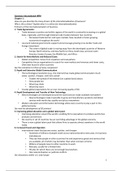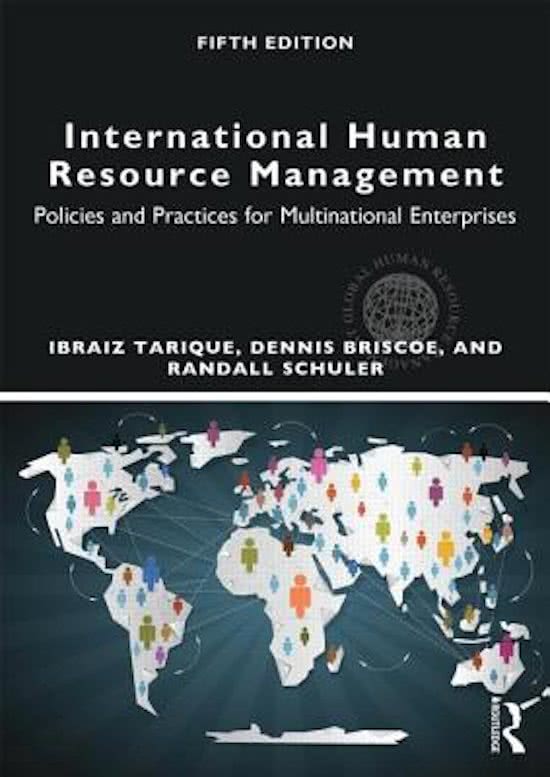Summary International HRM
Chapter 1:
How can you describe the many drivers of the internationalization of business?
Why is this a driver? Explain why it is a driver for internationalization.
9 Drivers of the internationalization of business:
1. Trade Agreements:
• Trade between countries and within regions of the world is constantly increasing on a global
basis, regionally, and thorough bilateral trade treaties between two countries
• Decreased trade barriers and open markets have resulted in faster-growing
economies throughout the world
• Local and national governments support and encourage growing cross-border trade and
foreign investment
• The center of global trade is moving away from the developed countries of Western
Europe, North America, and Asia Pacific to China, South Asia, and even Latin
America, Eastern Europe, the Middle East, and Africa
2. Search for New Markets and Reduced Costs:
• Global competition comes from anywhere and everywhere
• Competition forces organizations to search for new markets and revenues and lower costs,
often best found in other countries
See the relocation to China of many companies!
3. Rapid and Extensive Global Communication
• The technological revolution (e.g., the internet) has made global communication much
easier, quicker, cheaper, and more varied
• Enables the spread of information (on a global basis) about
• How people live
• What they think
• What they want
• Creates global expectations for an ever-increasing quality of life
4. Rapid Development and Transfer of New Technology
• New technologies are developed around the world and are made available everywhere
• New technologies make it possible to grow and manufacture products and deliver
services with world-class quality and prices everywhere
• Modern education and information technology allow every country to play a part in this
global economy
See now the development of 3D printers!
5. Improving global education and a global talent pool:
• Improving education around the world is enabling firms everywhere to produce world-class
products and services
• No country or set of countries has an overriding advantage in the global economy
• There is now a global talent pool that allows firms to operate almost anywhere in the world
today
6. Increased travel and migration
• International travel has become easier, quicker, and cheaper
• Hundreds of millions of people travel across national borders every year, for business
and pleasure
• They see how people in other countries live and experience goods and services that
are available, all of which may be better than what is known at home
• Millions of people move to other countries to work
• Relocate, usually for a limited time
• Fill jobs for which there are not enough local workers
• Flee natural disasters or political conflicts
See relocations within U.S. and Europe
1
, 7. Knowledge sharing:
• Firms operating internationally “export” their management philosophies and techniques to
their foreign subsidiaries
• Spread their knowledge and their company cultures everywhere
See spread of international conferences/congresses
8. E-commerce
• The World Wide Web and global transportation and logistics services have made it possible
for large, as well as small, firms to conduct business virtually
• If a business or an individual has a website, its business is global—anyone, from anywhere in
the world who has access to the web has access to that website
9. Homogenization of culture and consumer demands
• Integration of cultures and values have led to common consumer demands for some types of
products and services throughout the world
• Distinct differences in culture across countries remain
• Firms operating internationally need to be sensitive to these local differences
How can you describe the growth and spread of internationalization?
• Internationalization vs. globalization
• Both terms refer to the ever-increasing interaction, interconnectedness, and
integration of people, companies, cultures, and countries
globalization: integration of markets, technologies and nation-states that enables individuals,
corporations and nation-states to reach around the world farther, faster, deeper, and cheaper, and in
a way that enables the world to reach individuals, corporations and nation-states farther, faster,
deeper, and cheaper than ever before.
2






